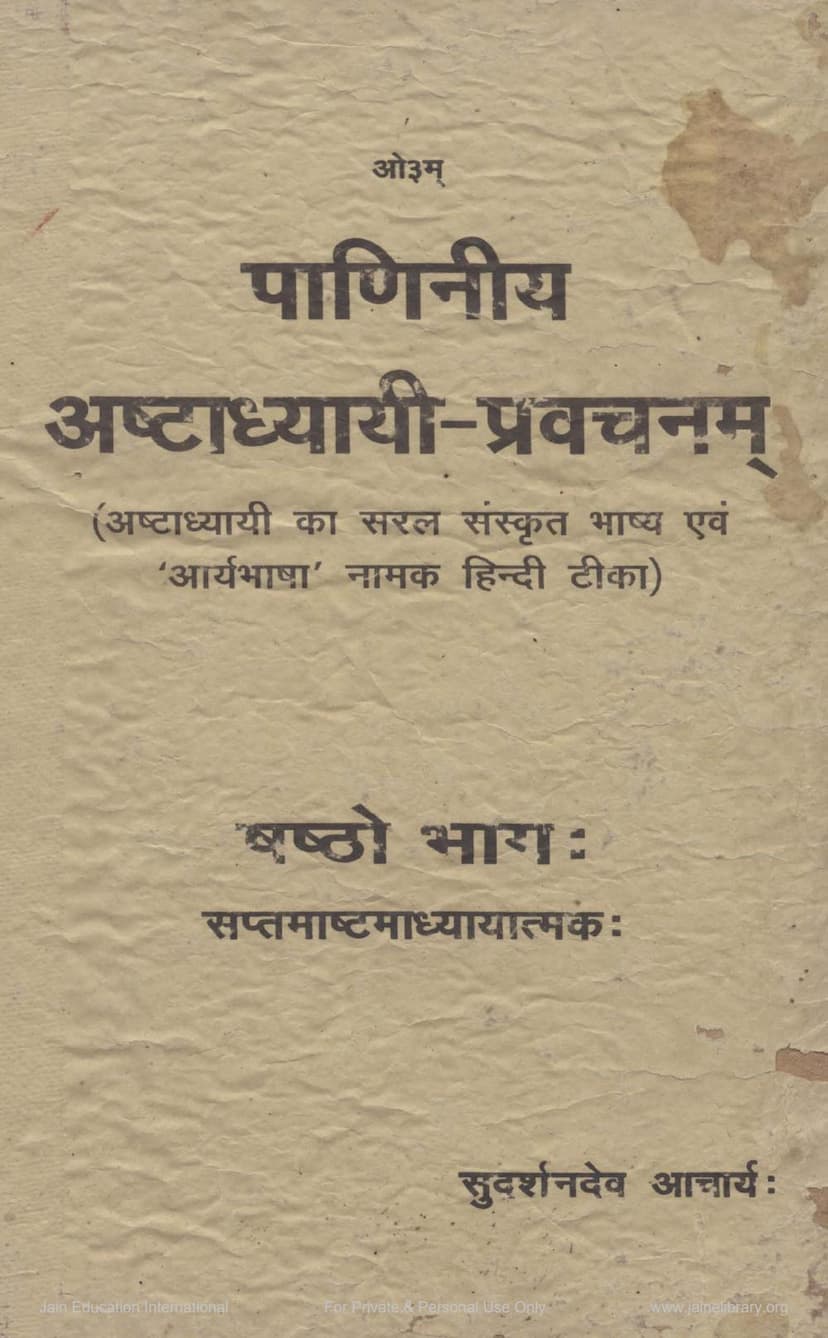Paniniya Ashtadhyayi Pravachanam Part 06
Added to library: September 2, 2025

Summary
Here's a comprehensive summary of the provided Jain text, "Paniniya Ashtadhyayi Pravachanam Part 06," authored by Sudarshanacharya, published by Bramharshi Swami Virjanand Arsh Dharmarth Nyas Zajjar, based on the provided pages:
Overall Summary:
This volume, the sixth part of the "Paniniya Ashtadhyayi Pravachanam" series, is authored by Dr. Sudarshan Dev Acharya. It presents a commentary on the seventh and eighth chapters of Panini's Ashtadhyayi, a foundational text for Sanskrit grammar. The work includes a simple Sanskrit commentary and a Hindi explanation titled 'Aryabhasha'. The publisher is Bramharshi Swami Virjanand Arsh Dharmarth Nyas, Gurukul Jhajjar, Haryana, and it was first published in 1999.
Key Themes and Content:
-
Historical Context of Grammar: The introduction (Anubhumika) provides a valuable historical overview by listing 25 prominent grammarians who preceded Panini, such as Maheshvara (Shiva), Indra, Vayu, Bharadvaja, and others. It highlights that Panini himself refers to 10 of these earlier scholars, including Apishali, Kashyapa, Gargya, Galava, Chakravartin, Bharadvaja, Shakatayana, Shakalya, Senaka, and Sphotayana, citing specific sutras where their views are mentioned. Brief introductions to these pre-Paninian scholars, including their estimated time periods and known works, are presented.
-
Detailed Grammatical Exposition (Chapters 7 & 8): The core of this volume is the systematic explanation of the grammatical rules (sutras) contained within the seventh and eighth chapters of the Ashtadhyayi. The text meticulously breaks down each chapter's content into its constituent "Padas" (sections or quarters) and then delves into individual grammatical topics.
-
Chapter 7: The summary lists various grammatical topics covered, including:
- Pratyayadesha Prakarana: Rules concerning the replacement of sounds within suffixes.
- Agama Prakarana: Rules concerning the insertion of sounds (augmentations).
- Vriddhiprakarana: Rules concerning the Vriddhi sound change.
- Adesha Prakarana: Rules concerning sound substitutions.
- Idagam Prakarana: Rules concerning the insertion of the vowel 'i' (It).
- Itpratishedha Prakarana: Rules prohibiting the insertion of 'It'.
- Nipatanam: Rules concerning irregular formations or exceptions.
- Abhyas Karyaprakarana: Rules concerning the reduplication of roots.
- Sarvanudatta Prakarana: Rules concerning the universal unaccented vowel sound in certain contexts.
- Avidyamana-vad-bhava Prakarana: Rules concerning the concept of treating something as non-existent for grammatical purposes.
- Nishtha Takaradesha Prakarana: Rules concerning the substitution of 't' in past participles.
- Assiddha Prakarana: Rules concerning principles of grammatical "non-existence" (Assiddha) for applying subsequent rules.
-
Chapter 8: The summary outlines the topics covered in the eighth chapter, including:
- Dvivachana Prakarana: Rules concerning the dual number.
- Padakarya Prakarana: Rules concerning word formation and modification.
- Sarvanudatta Prakarana: Rules concerning the universal unaccented vowel sound.
- Avidyamana-vad-bhava Prakarana: Rules concerning the concept of treating something as non-existent.
- Nishtha Takaradesha Prakarana: Rules concerning the substitution of 't' in past participles.
- Assiddha Prakarana: Rules concerning principles of grammatical "non-existence".
-
-
Commentary Style: The text appears to follow a standard Pāṇinian grammatical exposition style:
- Sutra Path: Presentation of the original Pāṇinian sutras.
- Vipatti Path (Padvichchhed): Breaking down the sutra into its constituent words.
- Anuvritti: Indicating which parts of previous sutras are carried over.
- Anvaya: Reordering the words of the sutra for clarity.
- Artha (Sanskrit Meaning): Explaining the grammatical rule in Sanskrit.
- Aryabhasha (Hindi Meaning): Providing the meaning of the rule in Hindi.
- Siddhi (Demonstration): Showing the derivation of grammatical forms based on the rules, often with detailed step-by-step analysis.
-
Author's Personal Journey: The author, Dr. Sudarshan Dev Acharya, shares his personal motivation for undertaking this work, stemming from his studies with his Guru, Pt. Vishwapriya Shastri, and a desire to write a simple commentary. He mentions completing this "mahan karya" (great work) after approximately 7 years of dedicated effort, overcoming health challenges, and retiring from government service. He also expresses gratitude to those who contributed to the book's printing and production.
In essence, this volume is a scholarly and detailed examination of specific sections of the Ashtadhyayi, aiming to make the complex grammatical rules accessible through a clear Sanskrit commentary and a Hindi explanation, along with practical examples.